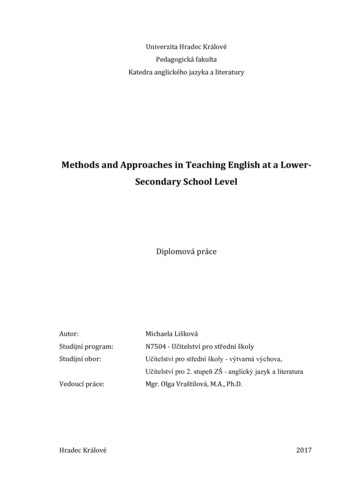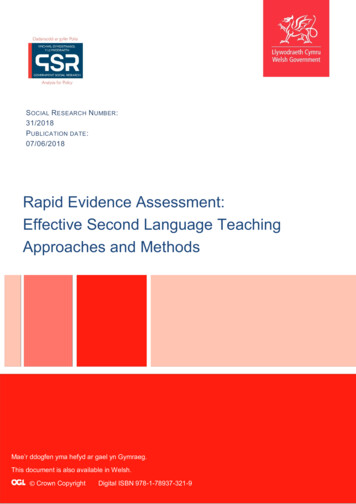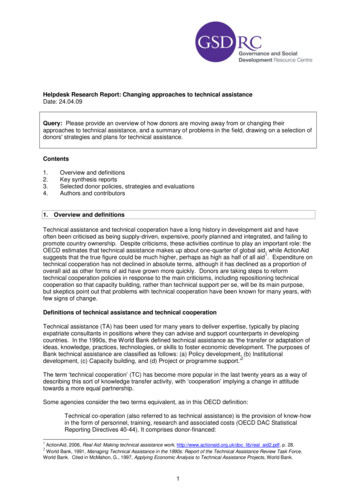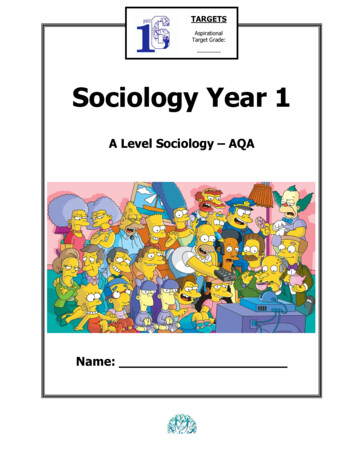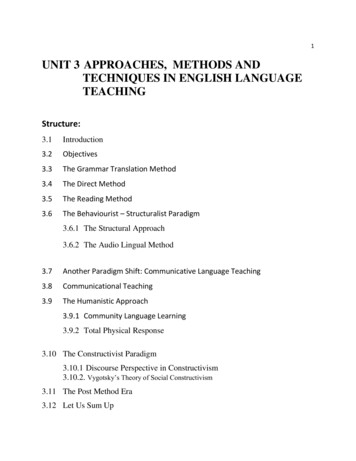
Transcription
1UNIT 3 APPROACHES, METHODS ANDTECHNIQUES IN ENGLISH ives3.3The Grammar Translation Method3.4The Direct Method3.5The Reading Method3.6The Behaviourist – Structuralist Paradigm3.6.1 The Structural Approach3.6.2 The Audio Lingual Method3.7Another Paradigm Shift: Communicative Language Teaching3.8Communicational Teaching3.9The Humanistic Approach3.9.1 Community Language Learning3.9.2 Total Physical Response3.10 The Constructivist Paradigm3.10.1 Discourse Perspective in Constructivism3.10.2. Vygotsky’s Theory of Social Constructivism3.11 The Post Method Era3.12 Let Us Sum Up
23.13 References and Further Reading3.14 Answers3.1 INTRODUCTIONSeveral methods of language teaching learning gained prominence in the twentiethcentury which are still being followed in the twenty first century. However, thetwenty first century has also thrown up certain exciting perspectives. In this Unit,we will further shed light on all these methods, looking at them from theperspective of the learner, the teacher and materials. We will also at the same timeask you to think ‘beyond’ the concept of methods. We wish to state at the outsetthat we do not promote the efficacy of any one method. We believe that a teacherknows her teaching-learning situation best and should use whatever methods suitsher context. But to be able to do this, you need to be aware of the current trendsaffecting methods of teaching learning and the rationale for them.‘Language educators have sought to solve the problem of language teaching byfocusing attention almost exclusively on method’ (Stern 1983). In other words,they have assumed that if a teacher teaches using the right method, learning willautomatically take place. Therefore, over the twentieth century, researchers havebeen constantly trying to find the ‘best’ method. However, language learners havenot really benefitted from these various methods. Scholars are now arguing thatperhaps we have been looking in the wrong direction all this while. Probably thereare variables besides methods which we need to take into account. Prabhu (1990)proposed that any attempt to find a best method was illogical because the teachersquite reasonably adapted and combined individual methods to suit their classroomscontexts and their own personal beliefs. Applied linguists like Pennycook (1989)suggested that teachers were frustrated because they could not implement anymethod fully and consistently because their context would not allow it. This searchfor a ‘best’ method also maintained an unequal relationship between theacademics/researchers and the actual teacher who had to engage with her class.As a result of this sustained criticism, the search for the best method has becomeless important in the twenty first century and scholars are now talking of a ‘postmethod’ era where the classroom teacher and her context is given more importanceand the teacher herself is encouraged to become a theoretician, theorizing from theclassroom.
3In the following sections, we shall discuss some of the teaching learning methodsthat have gained some prominence in the twentieth century and are still in use to agreater or lesser extent in the language classrooms in India.3.2OBJECTIVESAfter going through this unit you should be able to : understand how different methods have impacted language teaching learningin the 20th and 21st century; critically analyse and discuss the advantages and disadvantages of eachmethod; and use appropriate methods to enhance the teaching-learning process in yourclassroom.We have dealt more extensively with some of the methods than others, for exampleCommunicative Language Teaching (CLT) as they continue to be used verywidely even now.3.3 THE GRAMMAR TRANSLATION METHODThe grammar translation method was not based on any theory of languageteaching, but its roots can be traced to the way classical languages such as Latinand Greek were taught. It was a way of learning a language through a detailedstudy of its grammar. The learner then applied the rules of grammar in translatingsentences and parts of text from the mother tongue into the target language andvice versa. A distinctive feature of this method was its focus on translating thesentence correctly. Grammatical accuracy was given great importance. Literarytexts were the basis of this translation exercise. Vocabulary was taught throughbilingual word lists and there was a lot of stress on memorization of words. Inshort, listening and speaking were neglected and the skills of reading and writingoccupied an important place. In this method the teacher was totally dependent on
4the text as she had to rigidly follow the lesson with no scope for any innovation.The learner’s role was passive; s/he did not play any active role in the use of thelanguage. Look at the example given below:These are some of the activities that a teacher using the grammar-translationmethod would use from the reading passage given below.Reading passageI went out. And in the full blaze of sunlight in the field, stood two dogs, a blackand-white, and a big, bushy, rather handsome sandy-red dog, of the collie type.And sure enough this latter did look queer and a bit horrifying, his whole muzzleset round with white spines, like some ghastly growing; like an unnatural beard.The black-and-white dog made off as I went through the fence. But the red dogwhimpered and hesitated, and moved on hot bricks. He was fat and in goodcondition. I thought he might belong to some shepherds herding sheep in the forestranges, among the mountains.He waited while I went up to him, wagging his tail and whimpering, and duckinghis head, and dancing. He daren’t rub his nose with his paws any more; it hurt toomuch. I patted his head and looked at his nose, and he whimpered loudly.He must have had thirty quills, or more, sticking out of his nose, all the way round:the white, ugly ends of the quills protruding an inch, sometimes more, sometimesless, from his already swollen, blood-puffed muzzle.(From Reflections on the Death of a Porcupine by D. H. Lawrence)1. Write the mother tongue equivalents of the following words in paragraph 1:queer, horrify, ghastly--2. Translate the following sentences from the passage into the mother tongue. .iiiiiiI went out.The black-and-white dog made off as I went through the fence.I patted his head and looked at his nose, and he whimpered loudly.3Pick out the nouns, verbs, adjectives and adverbs from paragraph 1 and say
5what kind they are.Reflection1.Do you as a practicing teacher think that your students would benefit from suchactivities?2.Would this help them learn L2?Language experts of the early nineteen forties discarded the grammar translationmethod because they felt that learning about language through a detailed study ofgrammar was not the same as learning to use a language and that constanttranslation from the mother tongue stood in the way of the learner becoming afluent user of the target language. However, in recent years, there has been arevival of the grammar – translation tasks, albeit in a modified way. For example,teachers may often ask a pair of students to get a folk tale in their mother tongue.They may be asked to translate it into English and then compare their translationand make modifications where required. Thornbury (2006) recognizes that thegrammar translation may have survived due to its ease of implementation,especially with large classes.3.4 THE DIRECT METHODAs a reaction to the grammar translation method, the direct method emerged inEurope at the end of the 19th century. This method was based on the belief thatlearning a foreign language is similar to learning L1. This method emerged due tothe needs of late 19th and early 20th century contexts when international businessand travel required people to be able to use and communicate in L2. The primaryprinciples that characterize the Direct method are as follows:123Classroom interaction was conducted exclusively in the target language;The process of learning was essentially of forming associations, i.e.speech associated with appropriate objects, actions, concepts;Only everyday vocabulary and phrases were taught;
64Oral communication skills were organized in a graded manner and basedon question and answer exchanges between teachers and students insmall classes;Repetition was essential if associations had to be formed and reinforced;Grammar was taught inductively;Both listening and speaking were emphasized, andAccuracy of pronunciation and grammar was essential.Adapted from Richards and Rodgers 2001 and Nagaraj, G. (1996)5678The Direct method was demanding of both the learners andthe teachers both had to be highly motivated. Thismethod could be best implemented in schools where theclass size was rather small. The method placed the teacherat the centre and the role of the text book was minimized.There were a large list of dos and don’ts for the teacher,for example: Never translate: demonstrateNever explain: actNever imitate mistakes: correctNever speak single words: use sentencesNever speak too much: make students speak(cited in Titone, 1968:100-101)This method continues to be popular in the elite private schools in India. However,overuse of this method would be detrimental, because it not only rejects the mothertongue of the learners but also puts heavy demands on the teachers.This could be a possible activity conducted in the classroom using the Directmethod.Activity
7Teacher pointing to a picture of a girl:Teacher:This is Rita.She has black hair.She is wearing a blue dress.Teacher:Who is she? (Pointing to the picture)Class:Teacher:Class:Teacher:Class:She is Rita.What is the colour of her hair?It is black.What is the colour of her dress?It is blue.Check Your Progress 1Note: Write your answer in the space given below.1Write your own activity using the Direct Method for class nine students. . . . . . . . .3.5 THE READING METHODThis method was very popular in India soon after independence since English atthat time was envisaged to be a library language. Michael West who lived in Indiafor a long time was instrumental in popularizing this method. His new ‘methodreaders’ emphasized the importance of the reading skill. West believed that silentreading is the key to proficiency and that exercises in reading comprehensionwould enable proficiency in speech and writing. Vocabulary was seen as anessential component of reading proficiency. This led to the development of theprinciples of vocabulary control and resulted in the compilation of ‘a generalservice list of English words’. This was used as standard reference for developingteaching materials and Readers graded on the basis of vocabulary were created.
8Only the grammar necessary for reading comprehension was taught. Thevocabulary of the early reading passages and texts was strictly controlled fordifficulty. An attempt was made by the teacher to expand the vocabulary asquickly as possible, since the acquisition of vocabulary was considered moreimportant than the grammatical skills.English is no longer considered a library language in India. Therefore, theemphasis on the Reading Method can no longer be considered. However theimportance of vocabulary has again taken centre stage in English languageteaching learning.ReflectionHow do you teach vocabulary in your classroom? Do you teach it as part of thereading comprehension exercise or are there any other dimensions that youconsider?3.6 THE BEHAVIOURIST – STRUCTURALISTPARADIGM3.6.1 The Structural ApproachAbout 1940 and later, language experts like Charles Fries applied the principlesof behaviourism in psychology and structural linguistics to language teaching.They were of the view that different languages have different ways of expressingthe same meaning. These are what we call patterns or structures of the language.In any language, a pattern is made up of words, but in each language, the words areput together in certain specified ways. To be able to use the language, therefore,one needs to know the words and the order in which they occur in that language.To teach a language (English in the present context) a particular pattern or
9structure is presented and practiced thoroughly before the learner goes on to a newone. Only when a learner ‘masters’ the individual structures that make up thatlanguage, can s/he be expected to come out with an infinite number of newutterances as required by a situation. A learner in this approach is expected to beaccurate in whatever s/he says or writes and this grammatical accuracy is to berealized through constant drills and construction of correct (error free) sentencesfrom substitution tables. The aim of such substitution tables is to condition thepupils into using the correct forms of the structure by getting her/him to imitate orproduce many examples of the correct form, i.e., repeated reinforcement. In fact,errors were seen as serious aberrations which had to be removed immediatelybefore they became ‘habits’. Errors were considered to be the result of interferencefrom the first language, and were viewed as bad habits which were to be preventedat all costs and eliminated if they occurred. The focus of instruction did not movebeyond the sentence level.Teachers in India continue to be influenced by the structural approach and still usemanipulative drills, substitution tables and fill-in-the-blank exercises.Do you use exercises like the following?A.1IYouWeTheyHeSheB.Make as many correct sentences as you can from the following table.2havebeenhas been3watching TVdoing theassignmentspottering in thegardenpaintingwaiting for thedoctorcleaning thecupboards4for an hour since 8o’clock.Fill in the blanks with a or an where necessary:5
101. Raju hopes to be----------- engineer.2. He comes---------- home twice--------- week.3.Draw-------------- elephant.4. He is the son of---------------- accountant.ReflectionDo such exercises serve a useful purpose? What would the students learn fromsuch an exercise? What problems/advantages do you foresee in using such anexercise?3.6.2 The Audio Lingual MethodThe Audio Lingual Method was one of the methods which was based on theBehaviourist – Structuralist Paradigm. Towards the end of World War-II, theUS armed forces needed to learn foreign languages on a large scale as US soldiersneeded to communicate with both their allies as well as the enemy countries wherethey had been deployed. The languages taught ranged from European languagessuch as French and German to East Asian languages such as Japanese and Korean.This method focused on oral/aural work and pronunciation taught through drills aswell as dialogue practice in small groups of motivated learners and native languageteachers. Dialogues were the main aspect of the audio-lingual approach as theyprovided the learners an opportunity to mimic/imitate, practice and memorise bitsof language considered to be relevant to their situations. In fact, the Audio lingualmethod adapted many strategies of the Direct method, especially the emphasis onthe spoken skill. Based on the principle that language learning is habit formation,the method encourages imitation and memorization of set phrases. Structures aretaught one at a time using drills. Little or no grammatical explanation is provided.Vocabulary is limited and taught in context. There is use of language laboratories,tapes and visuals. Teaching points are often determined by the differences andsimilarities between L1 and L2, with an emphasis on the differences. Successfulresponses are reinforced; great care is taken to discourage errors, as it is felt theylead to bad habits. Great emphasis is given to native-like pronunciation.Read the following conversation. The verbs in bold are in the simple past tense:
11Priya:Venkat:Priya:Venkat:Priya:Venkat:Did you go someplace last week?Yes, I did.Did you have a good time?Yes, I did. I had a very good time.What time did you get home?My flight got in a little after eleven.Check Your Progress 2Note: Write your answer in the space given below.1Suggest the five key words which describe the Behaviourist model. . . .2Explain the main features of language learning through the structuralapproach. . .3.Write any two main features of the Audio Lingual method of languageteaching. . . . . .3.7 ANOTHER PARADIGM SHIFT: COMMUNICATIVE
12LANGUAGE TEACHINGCommunicative language teaching (CLT) emerged in Europe and in the USA inthe 1970s. This has been the dominant paradigm for several years in all thedifferent contexts where English is taught. It continues to be the major teachingmethodology in the Indian context even now.The origin of CLT can be traced to the changing view of language which veersaway from language structure towards language functions and communications(Hall, 2011). Thus language teaching moved away from individual linguisticstructures to teaching people how to use language effectively whencommunicating. In other words, it moved from linguistic competence tocommunicative competence (Hymes, 1972). Communicative competenceessentially suggests that forming grammatically correct sentence by the learners isnot enough, they should be able to use language appropriately in a variety ofsettings and situations and with different types of interlocutors.For example, linguists pointed out the hiatus that exists between form andfunctions of utterances. For example, how will you understand the utterance –‘Why don’t you close the door?’ What kind of a sentence is this in grammaticalterms? What meaning does this utterance convey? Is it a question or a request? Isit about asking someone to shut the door or asking someone why they are notshutting the door?To quote Littlewood, “ from a structural viewpoint the sentence isunambiguously an interrogative, from a functional viewpoint, however, it isambiguous. In some circumstances, it may function as a question. For example,the speaker may genuinely wish to know why his companion never closes a certaindoor. In others, it may function as a command – this would probably be the case ifa teacher addresses it to a pupil who had left the classroom door open. In yetanother situation, it would be interpreted as “a plea, a suggestion or a complaint”.In other words, whereas the sentence structure is stable and straightforward, itscommunicative function is variable and depends on specific situational and socialfactors. A second language learner may not be able to interpret or judge theintention of a speaker and would need to be taught.
13The key word in CLT is ‘learner centred’ and activities should be planned in such amanner where active learner participation is essential. Unlike other approacheswhere the learner has a passive role, here the learner is the active agent andnegotiator who must contribute as much as s/he gains in a cooperative atmosphere.Hence, there is a great emphasis on pair work and group work. The teacher’s rolealso changes to that of a facilitator, organizer, guide, monitor, manager andcounselor. The teacher has to facilitate the communication process between thelearners, the text and the various activities which the student and the teachers mustparticipate in together.The communicative approach to language teaching also ushered in an era offluency over accuracy and the teacher was expected to stress more on the‘meaning of a message conveyed’ rather than on the ‘grammatical correctness ofthe utterance’.In the initial stages the syllabus based on CLT concentrated on the notionalfunctional syllabus. However, the focus later became more eclectic. There wereprimarily three types of materials used: 1 - text based, 2- task based and 3) realia(authentic material). The textbooks produced according to CLT in the Indiancontext have been varied. Many of them have followed the traditional ‘structural’syllabus but included tasks which include games, role plays, information gap,problem solving and so on. Many of the books have also been divided aroundthemes which are close to the student’s world, such as - my family, school,holidays, travel, culture, environment and so on. Realia has also been included aspart of CLT, i.e. posters, advertisement, maps, train schedule, graphs. The tasks sethave a specific communicative purpose and train the learners to be fluent as well asaccurate, although CLT has tended to emphasize fluency over accuracy.Example of a problem solving activity:In the passage below, two paragraphs are jumbled up. Can you separatethem again into two paragraphs?Once there lived a cruel wolf in a town. One day a king saw an old manplanting small mango plants. He asked him, "When will you get any fruitfrom these plants?" Saint Francis visited the town and wanted to see thewolf. The king laughed and said "You'll die before the trees bear fruit."
14People told him that he would be killed. But the saint would not listen. Theold man smiled and said "Yes, but others will eat the fruit. Now, I am eatingthe fruit from the trees which my grandfather planted." He went into theforest. When the wolf ran towards him, he said "Come here Brother Wolf”.The king was ashamed. The cruel wolf closed its mouth and sat down at hisfeet.Example of Gap filling activityRamesh Sinha is 12 Years old. He was born on 10th May 2001. His fatherRakesh Sinha is a doctor. They live at No. 10, Kutab Institutional Area,Delhi. Ramesh studies in Adarsh Vidyalaya. He plays cricket and chess. Hishobbies include painting and coin collection. Ramesh wants to join the localchildren's club. Could you help him fill in the application form below?The Kutab Children's ClubName:Age:Date of Birth:Father's Name:Father's Occupation:Mother's Name:Mother's Occupation:Address:Name of School:Hobbies:Any Special Interest:(The teacher could get photocopies of authentic forms and ask the childrento fill them).However, all methods are subject to criticism, and from the 80’s itself there was a
15questioning of CLT. Brumfit (1984) for example, questioned the over emphasis onfluency at the cost of accuracy. Towards the late eighties there was again anemphasis on grammar teaching and vocabulary acquisition which had beenrelegated to the background in the early years of CLT. Additionally, the so-calledauthenticity of communicative activities was questioned. Widdowson (1998) forexample questioned the authenticity of tasks such as giving directions in aclassroom context, suggesting that such pair work activities cannot be termedgenuine, taken away as it were from the context in which it is required. Moreover,it was suggested that CLT was not appropriate for all cultures and contexts. Forexample, pair work, group work, and less teacher intervention may not be suitablein more traditional cultures where there are certain expectations from a teacher.Check Your Progress 3Note: Write your answer in the space given below.1. How is ‘linguistic competence’ different from ‘communicative competence’?Explain with examples. . . . . .2. Why did communicative language teaching not produce the results it wasexpected to? 3.8COMMUNICATIONAL TEACHINGCommunicational teaching refers to a five-year project of exploratory teaching ofEnglish as a second language which was ‘planned, carried out and reviewedregularly by a group of interested teacher trainers and teachers of English as a parttime activity but with institutional support from the Regional Institute of English,
16Bangalore and the British Council in Madras (now Chennai) from 1979 to 1984’(Prabhu 1987) .The origin of this project was ‘A strongly-felt pedagogic intuitionthat the development of competence in a second language requires notsystematization of linguistic inputs or maximization of planned practice, but ratherthe creation of conditions in which learners engage in an effort to cope withcommunication.’ This project and its findings caused a lot of excitement all overthe world and while it has not been formalized into an approach, it greatlyinfluenced other approaches, especially the Task based approach to languageteaching.Some features of the communicational teaching It was a reaction against the structural-oral-situation method that waspredominant at the time where the focus was on structure and its repetition. Problem-solving activities or tasks were the main thrust of the teachinglearning process. The communicational syllabus was not based on preselected language items but driven by the difficulty level of the tasks. The tasks provided ‘meaning-focused’ activity that required students tounderstand and convey meaning and where attention to language forms wasincidental. These tasks were primarily cognitive in nature. In dealing with the class, the teacher controlled her language just as anyadult would do when speaking to a child. This is called ‘natural control’. In communicational teaching the learner has to engage with more than onelanguage that may be required for problem-solving activities. Hence the useof mother tongue or other languages were not prohibited.Sample taskGiven below are a few of the tasks used during the project:CTP Lesson: 30 January 1981Standard VIIIThe following is written on the blackboard9.15 amMr. GeorgeLeaves home
179.45 am10.45 am3.30 pm5.30 pm6.00 pm9.45 am10.00 am12.30pm12.45pm1.45 pm2.00 pm4.30 pm4.45 pmArrives at his officeGoes to the courtReturns to his officeLeaves the officeArrives homeMrs. GeorgeLeaves homeArrives at thecollegeLeaves the collegeArrives homeLeaves homeArrives at thecollegeLeaves the collegeArrives homePre-task: Questions which are deliberately varied in form are as follows:1Where is Mr. George at 10.00 am?2Who leaves home first in the morning?3When does Mrs. George arrive at the college, in the afternoon?4How long does Mrs. George take to go from her house to the college?5Who is at home at 1.00pm?6How much time does Mr. George spend at his office, in the morning?Task:12345678Who comes home last, in the evening?Where is Mrs. George at 1.30 pm?How much time does Mrs. George spend at the college, in the morning?When does Mrs. George leave the college in the afternoon?Who is at home at 9.30 pm?Where is Mr. George at 4.30 pm?How long does Mr. George spend at his office in the afternoon?Who does not come home for lunch?
18Pre –task is guided by the teacher. It is a whole class activity. The pre- task activityis meant to orient the learner for the task based activity, which means the learner isexpected to do the task by herself.(Nagaraj, 1996, pp 92 -93)3.9 THE HUMANISTIC APPROACHThe Humanistic movement in language teaching emerged, as did some of the otherapproaches, from developments which occurred in education and psychology. Theideational basis of humanistic education was developed by authors such as Maslow(1970) and Rogers(1961). In terms of acquisition of L2, this approach argued evenmore strongly against the authoritarian teacher-centred classroom and emphasizedthe importance of creating environments which minimized anxiety, enhancedpersonal security and promoted genuine interest through a deeper engagement ofthe learner’s whole self (Roberts, 1975). Unlike the Communicative approachwhich to a large extent remained syllabus –centred, the Humanistic approachpermitted students to diagnose their own needs and create their syllabus. The keyconcerns of this paradigm shift included factors such as the following: Respect for learners as people, being sensitive to their feelings andencouraging respect for each other. The affective nature of the learningexperience was emphasized. Respect for the learners own knowledge and independence, and faith thatlearners know best how and when to learn. The classroom activities focusedon what the learners wished to engage in. This contributed to learnerautonomy and critical thinking skills as well as encouraged self-discovery. Responsibility and respect for the need for criticism and correction. Teachers were regarded as enablers and facilitators who assisted the learnersin their process of self-discovery rather than instructors that transmitknowledge to learners.The ways in which these psychological and educational principles can be
19implemented in second language teaching learning was explored and tried outby four language teaching methods. These include ‘Asher’s Total PhysicalResponse, Curran’s Community Language Learning, Gattegno’s Silent Way,and Lozanov’s Suggestopedia.’ We shall discuss briefly two of these methodswhich will bring out the ways in which the basic principles of humanism can berealized in the classroom.3.9.1 Community Language LearningCharles Curran, who was the originator of community language learning (CLL),was a catholic priest who taught psychology and counseling. His approach toteaching L2 is heavily influenced by the methods of counseling therapy. In aCLL class, learners typically sit in a circle and talk naturally about the subjectwhich is of personal relevance to them. The learners may speak either in thefirst language L1 or in the L2. The teacher stands behind the learner who isspeaking and either gives the L2 translation of what the learner has said in L1,or reformulates the learner’s L2 utterance correctly and appropriately. Thelearner
UNIT 3 APPROACHES, METHODS AND TECHNIQUES IN ENGLISH LANGUAGE TEACHING Structure: 3.1 Introduction 3.2 Objectives 3.3 The Grammar Translation Method 3.4 The Direct Method 3.5 The Reading Method 3.6 The Behaviourist – Structuralist Paradigm 3.6
